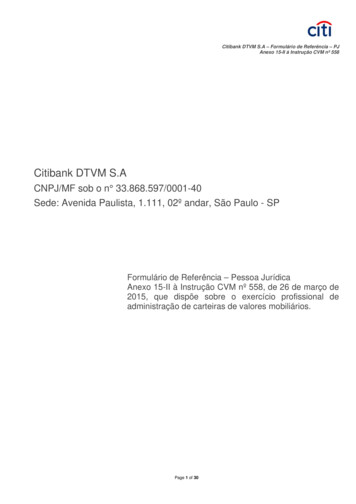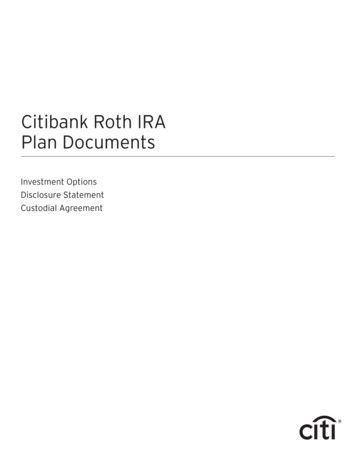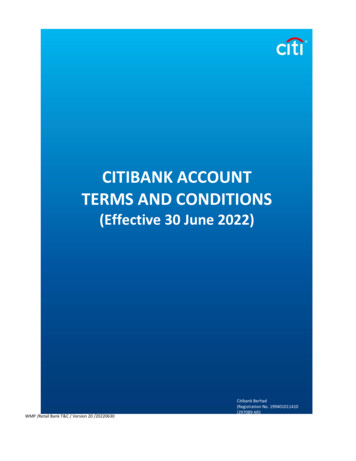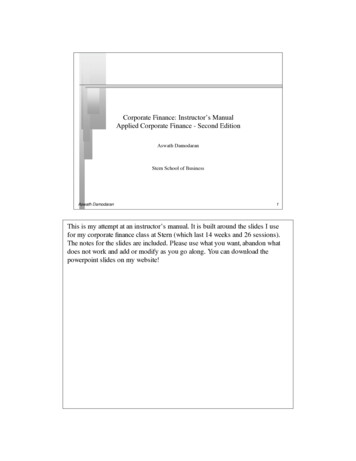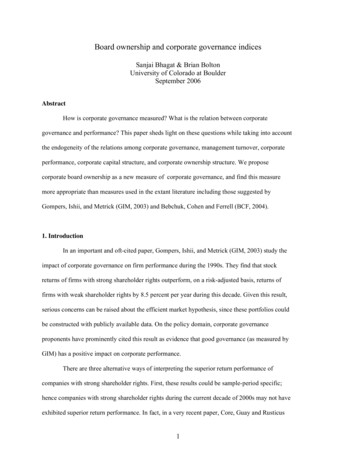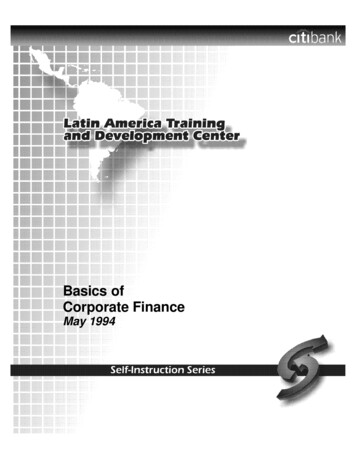
Transcription
Basics ofCorporate FinanceMay 1994
Basics of Corporate FinanceWarningThese workbook and computer-based materialsare the product of, and copyrighted by, Citibank N.A. They are solely for the internal use ofCiti-bank, N.A., and may not be used for anyother purpose. It is unlawful to reproduce thecontents of these materials, in whole or in part,by any method, printed, electronic, or otherwise; or to disseminate or sell the same withoutthe prior written consent of the ProfessionalDevelopment Center of Latin America GlobalFinance and the Citibank Asia Pacific BankingInstitute.Please sign your name in the space below.
Table of Contents
TABLE OF CONTENTSIntroduction: Basics of Corporate FinanceCourse Overview.xiCourse Objectives .xivThe Workbook.xvUnit 1: Financial Statement AnalysisIntroduction.1-1Unit Objectives .1-1Balance Sheet.1-2Assets .1-2Short-term Assets . 1-3Long-term Assets. 1-3Liabilities (Debt) and Equity .1-4Debt vs. Equity . 1-4Liability / Equity Accounts . 1-5Assets Equal Liabilities Plus Equity .1-6Summary.1-8Progress Check 1.1.1-9Income Statement .1-13Shareholder Return on Investment .1-15Depreciation.1-16Summary.1-17Progress Check 1.2.1-19Cash Flow Statement .1-21Operating Activities .1-23Sources.1-23Uses .1-24Financing Activities.1-25Summary.1-27v05/15/94p01/14/00v-1.1
iiTABLE OF CONTENTSUnit 1: Financial Statement Analysis (Continued)Progress Check 1.3. 1-29Financial Ratios . 1-33Liquidity Ratios. 1-35Current Ratio . 1-35Quick (Acid-Test) Ratio. 1-36Asset Management Ratios . 1-36Inventory Turnover Ratio. 1-36Average Collection Period. 1-37Fixed Assets Turnover Ratio . 1-38Total Assets Turnover Ratio. 1-38Debt Management Ratios. 1-39Total Debt to Total Assets Ratio (Debt Ratio) . 1-40Times Interest Earned (TIE) Ratio. 1-41Fixed Charge Coverage Ratio . 1-41Profitability Ratios. 1-42Profit Margin Ratio. 1-42Basic Earnings Power Ratio . 1-42Return on Total Assets Ratio . 1-43Return on Common Equity Ratio. 1-43Market Value Ratios . 1-44Price / Earnings Ratio . 1-44Market / Book Ratio. 1-45Using Ratios . 1-45Unit Summary. 1-46Progress Check 1.4. 1-49Unit 2: Financial Markets and Interest RatesIntroduction.2-1Unit Objectives .2-1Overview of Financial Markets .2-2v-1.1v05/15/94p01/14/00
TABLE OF CONTENTSiiiUnit 2: Financial Markets and Interest Rates (Continued)Market Players .2-2Types of Financial Markets.2-2Money Markets. 2-3Capital Markets. 2-3Interest Rates.2-5Calculating Interest Rates .2-6Pure Interest Rate . 2-7Inflation . 2-7Risk. 2-8Term Structure of Interest Rates.2-10Yield Curve.2-10Normal Yield Curve Theories.2-12Effect on Stock Prices.2-14Unit Summary.2-14Progress Check 2 .2-17Unit 3: Time Value of MoneyIntroduction.3-1Unit Objectives .3-1Future Value .3-2Calculating Interest Payments .3-2Simple Interest.3-3Practice Exercise 3.1 .3-5Compound Interest.3-9Discrete Compounding for Annual Periods . 3-9Discrete Compounding for Nonannual Periods. 3-11Continuous Compounding . 3-12Summary. 3-16Practice Exercise 3.2 . 3-17Present Value . 3-21v05/15/94p01/14/00v-1.1
ivTABLE OF CONTENTSUnit 3: Time Value of Money (Continued)Discrete Discounting . 3-22Continuous Discounting . 3-24Practice Exercise 3.3 . 3-27Annuities . 3-31Future Value of an Annuity . 3-31Present Value of an Annuity. 3-32Perpetuities . 3-33Uneven Payment Streams .3-34Practice Exercise 3.4 .3-37Unit Summary.3-41Progress Check 3 .3-43Unit 4: Valuing Financial AssetsIntroduction.4-1Unit Objectives .4-1Bonds .4-1Bond Terminology.4-2Process for Issuing Bonds .4-3Pricing Bonds.4-4Common Stock .4-7Valuing Common Stock .4-7Preferred Stock.4-11Pricing Preferred Stock.4-11Unit Summary.4-12Progress Check 4 .4-15Unit 5: Introduction to Capital BudgetingIntroduction.5-1Unit Objectives .5-1Nominal and Effective Rates .5-2Calculating Effective Interest Rates .5-2v-1.1v05/15/94p01/14/00
TABLE OF CONTENTSvUnit 5: Introduction to Capital Budgeting (Continued)Adjusting for Inflation.5-4Practice Exercise 5.1 .5-7Net Present Value .5-9Present Value of Cash Flows .5-9Net Present Value of Cash Flows .5-10Practice Exercise 5.2 .5-13Internal Rate of Return .5-15Adjusting NPV and IRR for Inflation.5-17Other Methods for Making Investment Decisions .5-18Payback Period .5-18Profitability Index (PI) .5-20Practice Exercise 5.3 .5-23Unit Summary.5-27Progress Check 5 .5-29Unit 6: Corporate Valuation RiskIntroduction to Units 6, 7, and 8 – Corporate Valuation.6-1Introduction.6-3Unit Objectives .6-3Calculating Expected Cash Flows .6-4Expected Return.6-4Expected Cash Flows .6-7Practice Exercise 6.1 .6-9Measuring Risk .6-11Variance.6-13Standard Deviation.6-16Summary.6-18Practice Exercise 6.2 .6-19Portfolio Risk .6-21Portfolio Diversification.6-21Systematic and Unsystematic Risk.6-27v05/15/94p01/14/00v-1.1
viTABLE OF CONTENTSUnit 6: Corporate Valuation – Risk (Continued)Summary. 6-30Practice Exercise 6.3 . 6-31Beta . 6-33Summary. 6-37Practice Exercise 6.4 . 6-39Symbols and Definitions . 6-41Risk vs. Return. 6-42Required Rate of Return. 6-42Capital Asset Pricing Model (CAPM). 6-45Practice Exercise 6.5 . 6-49Unit Summary. 6-53Unit 7: Corporate Valuation – Cost of CapitalIntroduction.7-1Unit Objectives .7-1Sources of Capital and Their Costs.7-1Cost of Debt .7-2Cost of Preferred Stock .7-3Cost of Common Stock (Equity).7-4Dividend Valuation Model. 7-5Capital Asset Pricing Model (CAPM). 7-6Summary.7-8Practice Exercise 7.1 .7-9Weighted Average Cost of Capital.7-15Capital Structure .7-17Flotation Costs .7-18Summary.7-19Practice Exercise 7.2 .7-21v-1.1v05/15/94p01/14/00
TABLE OF CONTENTSviiUnit 8: Corporate Valuation – Estimating Corporate ValueIntroduction.8-1Unit Objectives .8-1Forecasting Cash Flows .8-1Free Cash Flow Calculation . 8-2Assumption-based Cash Flow Forecasting . 8-4Residual Value .8-7Perpetuity Method.8-8Growing Perpetuity Method .8-9Other Methods.8-10Summary.8-10Practice Exercise 8.1 .8-11Discounted Cash Flow Method .8-13Placing Value on a Company .8-13Summary.8-18Practice Exercise 8.2 .8-19Other Valuation Methodologies.8-21Price / Earnings Ratio .8-21Market / Book Ratio.8-23Liquidation Value .8-24Dividend Value .8-24Other Ratios.8-25Factors Affecting Value .8-26Market Liquidity.8-26Country Conditions .8-27Industry Conditions.8-28Synergies.8-28Unit Summary.8-29Progress Check 8 .8-31v05/15/94p01/14/00v-1.1
viiiTABLE OF CONTENTSUnit 9: Fixed Income SecuritiesIntroduction.9-1Unit Objectives .9-1Introduction to Bond Pricing and Yield Mathematics.9-2U.S. Treasury Bills.9-2Pricing U.S. Treasury Bills . 9-3Calculating the Discount Rate . 9-4Rate of Return. 9-4Summary. 9-6Practice Exercise 9.1 .9-9U.S. Treasury Notes. 9-11Pricing U.S. Treasury Notes . 9-11Calculating Yield to Maturity. 9-13U.S. Treasury Bonds. 9-14Call Provision . 9-14Summary. 9-15Practice Exercise 9.2 . 9-17Eurobonds . 9-19Other Bonds. 9-21Accrued Interest . 9-21Bond Price Quotes . 9-23Treasury Bill Quotes. 9-23Treasury Note and Bond Quotes. 9-25Summary. 9-27Practice Exercise 9.3 . 9-29Duration. 9-33Factors That Affect Bond Prices . 9-33Duration of a Bond . 9-34Duration of a Portfolio. 9-37Duration Relationships . 9-38Summary. 9-39v-1.1v05/15/94p01/14/00
TABLE OF CONTENTSixUnit 9: Fixed Income Securities (Continued)Practice Exercise 9.4 . 9-41Unit Summary. 9-43Unit 10: Derivative SecuritiesIntroduction. 10-1Unit Objectives . 10-1Options . 10-1Background and Markets. 10-3Payoff Profile for Calls and Puts. 10-4Call Options . 10-4Put Options . 10-6Summary. 10-9Swaps . 10-9Interest Rate Swaps. 10-9Currency Swaps.10-14Unit Summary.10-15Progress Check 0v-1.1
xTABLE OF CONTENTS(This page is intentionally blank)v-1.1v05/15/94p01/14/00
Introduction
INTRODUCTION: BASICS OF CORPORATE FINANCECOURSE OVERVIEWBasics of Corporate Finance serves as an introductory course for students beginningtheir study of finance and financial markets. The ideas and calculations presented inthis workbook serve as the foundation for continued study in the areas related tocorporate finance and the capital and derivative markets. The purpose of this courseis to help the student build a working vocabulary of the financial world and tounderstand the basic computations used by analysts working in the corporate financefield. The terms and ideas covered in this course will provide the backgroundnecessary for the student to understand concepts presented in future courses.This workbook serves as a foundation for other courses in the series. It is comprisedof ten units.UNIT 1: Financial Statement AnalysisThe first unit in the workbook is an introduction to the financial statements of acompany. This unit briefly explains the purpose of each financial statement andprovides definitions for the common items found in each of the statements. Theunit also introduces ratio analysis and its use in the analysis of the finances andoperations of a firm. The unit focuses on definitions of key terms, although somesimple mathematical calculations and relationships are introduced and explained.UNIT 2: Financial Markets and Interest RatesThe next unit is a brief overview of the financial markets and the components ofinterest rates. This unit will help you understand how financial markets operate andto identify the participants in the markets. A brief discussion of interest rates andthe role they play in the financial markets is also included. The unit's focus ismainly to identify and define key terms; it does not require any mathematicalcalculations.v05/15/94p01/14/00v-1.1
xiiINTRODUCTIONUNIT 3: Time Value of MoneyThe time value of money is introduced in this unit. You will learn how and why thevalue of money changes over time. You will also be introduced to the ideas ofpresent value and future value and how those computations are used to evaluate apotential investment. The topics in this unit are quantitative, with several formulasintroduced and explained. All of the computations can be completed using afinancial calculator. You will learn how to identify the key variables necessary forinput into the calculator to find the proper solution. The concepts presented in thisunit are important because much of the remainder of the workbook builds uponthem.UNIT 4: Valuing Financial AssetsAn introduction to the process of valuing financial assets is provided in this unit.These simple methods for valuation are based on the ideas presented in Unit Three.The unit provides an explanation of some of the basic terms associated withfinancial assets. Basic formulas used to place a value on simple financial assets(bonds, preferred stock, and common stock) are also demonstrated. The unitrequires some mathematical calculations, but all are simple and straight-forward.The ideas for valuing these securities serve as building blocks when more complexsecurities are being considered.UNIT 5: Introduction to Capital BudgetingThe basic ideas and methodologies surrounding capital budgeting are introduced inUnit Five. You will see how the idea of present value can be used to evaluatealternatives for capital investment when resources are scarce. The most importantpoints in this unit are the calculation of net present value and internal rate ofreturn. These two computations are important for the evaluation of many types ofprojects and securities. Most financial calculators will perform the computations,and we will demonstrate how to identify the key variables needed for input intoyour calculator.v-1.1v05/15/94p01/14/00
INTRODUCTIONxiiiUNIT 6: Corporate Valuation – RiskIn this unit, some real-world complications, including risk and uncertainty, areapplied to some of the simple ideas presented earlier. More specifically, you willsee how an analyst may make assumptions concerning the future operations of afirm in order to estimate future cash flows. From these estimates, a value can beplaced upon the firm or project. Some key statistical terms are presented. Theseideas and terms are used to build the foundation for the capital asset pricing model(CAPM). This model is the most widely-used method for calculating the value of afirm. The unit has many calculations and you should feel comfortable identifyingthe key variables needed to use the CAPM.UNIT 7: Corporate Valuation – Cost of CapitalThe main focus of this unit is a discussion of each component of capital and thecosts associated with the use of each component. You will see how these costs arecombined in the proper proportions to find the weighted-average cost of capital(WACC). This is the appropriate rate to be used to discount a set of future cashflows. This unit contains both key terms and important computations used later inthe course.UNIT 8: Corporate Valuation – Estimating Corporate ValueThe ideas presented in Units Six and Seven are brought together in this unit. Anestimate of corporate value can be found by forecasting a set of cash flows anddiscounting them at the weighted average cost of capital. You will be introduced toa relatively simple method for forecasting cash flows based on a set ofassumptions concerning the future operations and finances of a company. Othermethods for estimating corporate value are presented and the relative strengths andweaknesses of each are discussed. The unit requires some simple calculations,including applications of the WACC and present value.UNIT 9: Fixed Income SecuritiesIn this unit you will revisit the debt markets discussed briefly in Units Two andFour through the introduction of the mathematics which surround fixed incomesecurities (bonds). The calculations of yield and rate of return concerning bondsmaking fixed interest payments are introduced and the relationship between theyield and the price of a bond are discussed. The unit also includes a discussionof duration and its calculation. All of the computations are rel
The next unit is a brief overview of the financial markets and the components of interest rates. This unit will help you understand how financial markets operate and to identify the participants in the markets. A brief discussion of interest rates and the role they play in the financial markets is also included. The unit's focus is

